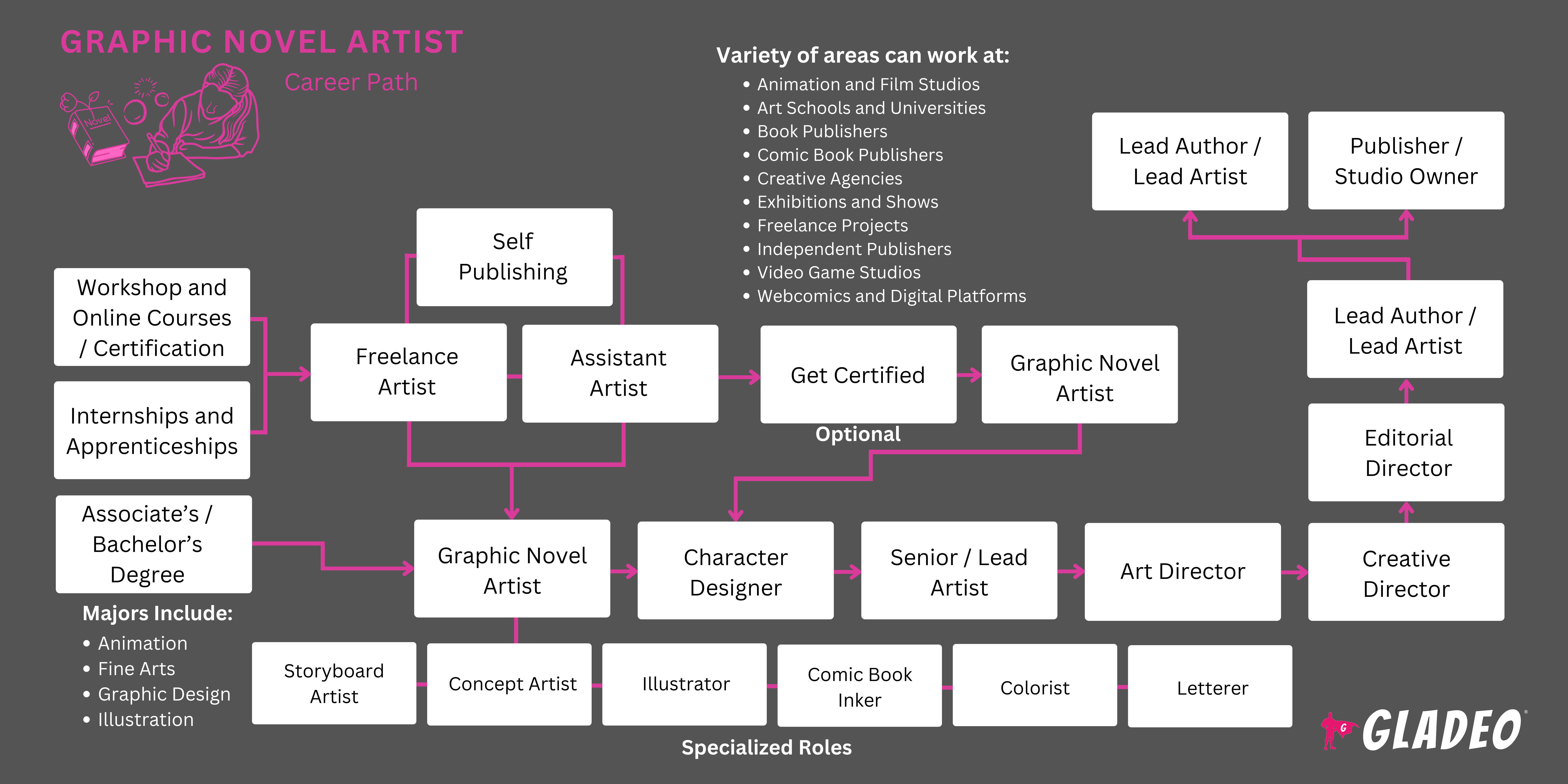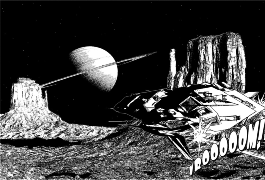스포트라이트
코믹북 아티스트, 시퀀셜 아티스트, 그래픽 일러스트레이터, 그래픽 스토리텔러, 비주얼 내러티브 아티스트, 그래픽 소설가, 그래픽 일러스트레이터/작가, 그래픽 북 크리에이터, 그래픽 소설 일러스트레이터, 코믹 스트립 아티스트
Graphic Novel Artists are visual storytellers who turn words and ideas into colorful, action-packed pages. They draw the characters, scenes, and emotions that bring stories to life—just like the ones you see in comic books or manga. Whether they’re creating epic adventures, mystery tales, or heartwarming stories about everyday life, these artists use their imagination, drawing skills, and sense of storytelling to make readers feel like they’re part of the world on the page. Some work with writers and editors to complete a book, while others write and illustrate their own stories from start to finish.
This career is perfect for people who love to draw and tell stories. Graphic Novel Artists sketch characters, plan how each page will flow, and use digital tools like Procreate or Clip Studio Paint to add color and special effects. They think like movie directors—deciding what each “shot” should look like and how to make scenes exciting or emotional. Their finished work can be published in print, posted online as webcomics, or shared with fans all over the world. For creative students who dream of combining art and storytelling, being a Graphic Novel Artist is a chance to make imagination come alive.
- Watching your characters come alive on the page—and in the minds of readers.
- Seeing your name printed on a published book or credited on a digital platform.
- Building a loyal fan base who connect with your stories and art style.
- Collaborating with writers, colorists, and editors to create something unforgettable.
- Having the freedom to express ideas, emotions, and cultures through art.
근무 일정
Graphic Novel Artists often work full-time or on a project-by-project basis. Deadlines can mean long hours, especially close to publication dates. Freelancers may work from home studios, coffee shops, or shared creative spaces, while others work in offices with publishers, game studios, or animation companies.
일반적인 의무
- Brainstorm story ideas and develop scripts or storyboards.
- Sketch characters, scenes, and panel layouts.
- Use digital illustration tools (like Clip Studio Paint, Procreate, or Photoshop) to finalize artwork.
- Collaborate with writers, editors, and colorists to maintain consistency and style.
- Review and revise artwork based on feedback.
- Prepare files for print or digital publication.
추가 책임
- Attend comic conventions, artist expos, or online events to showcase and sell your work.
- Manage social media accounts or personal websites to build an audience.
- Negotiate contracts and royalties with publishers or clients.
- Keep up with art trends, printing technology, and storytelling techniques.
- Maintain organized digital portfolios and backups of your work.
- Mentor junior artists or collaborate on indie projects to expand creative networks.
A typical day starts with sketching or reviewing storyboards over a cup of coffee. Many artists begin by outlining the next few pages, blocking out scenes, and adjusting character poses. The afternoon might be spent inking pages, coloring digitally, or attending virtual meetings with editors.
When deadlines loom, the workday can stretch late into the night—but seeing a finished page come together makes it worth it.
“One way of understanding a graphic novel is that it’s an ambitious comic and one way or another my comics have had ambitions. I have no problem with escapism. When I get my depressions all I want to do is escape reality.” — Art Spiegelman, creator of the graphic novel Maus
소프트 스킬
- Creativity and imagination
- Storytelling and pacing
- 세부 사항에주의
- 시간 관리
- Communication and collaboration
- Self-motivation and discipline
- 문제 해결
- Openness to feedback
- Perseverance under tight deadlines
기술 능력
- Drawing and illustration (digital and traditional)
- Visual composition and perspective
- Panel layout and storytelling flow
- Knowledge of anatomy and facial expression
- Digital art software (Adobe Creative Suite, Clip Studio Paint, Procreate)
- Typography and lettering
- Color theory and shading
- File formatting for print and web publishing
- Basic understanding of copyright and licensing
- Independent Artists: Create, illustrate, and self-publish their own works.
- Studio Artists: Work for publishers or animation/game companies as part of a creative team.
- Collaborative Artists: Focus on either line art, coloring, or lettering within a team.
- Writer-Illustrators: Develop both the script and the art for original stories.
- Comic book and graphic novel publishers (Marvel, DC, Image, Dark Horse, Viz Media)
- Animation and game studios
- Webtoon and digital comic platforms (Webtoon, Tapas, GlobalComix)
- Freelance marketplaces and independent presses
- Educational or corporate illustration projects
Graphic Novel Artists must often balance passion with persistence. Deadlines can be demanding, revisions can be constant, and freelance income can fluctuate. Creating hundreds of detailed pages for a single book requires stamina and time management.
You’ll spend long hours drawing and refining your craft—sometimes without immediate financial reward—but over time, your style, reputation, and portfolio will open doors to more creative freedom and steady work.
- Digital Publishing Boom: Webtoons, online comics, and digital platforms are reshaping the industry.
- Diverse Storytelling: There’s growing demand for stories from different cultures and perspectives.
- Hybrid Art Styles: Artists blend Western comic art, manga influences, and digital painting techniques.
- AI and 3D Tools: Some artists use AI for reference poses or backgrounds, though traditional hand-drawn art remains essential.
- Crowdfunding: Platforms like Kickstarter and Patreon allow independent artists to fund their projects directly through fans.
Most Graphic Novel Artists loved drawing—sometimes in the margins of their notebooks! Many created their own characters, copied scenes from favorite comics, or made fan art. They often enjoyed storytelling, creative writing, or watching animated shows and movies. Others loved reading graphic novels, manga, or fantasy books and dreamed of creating worlds of their own one day.
Graphic Novel Artists don’t always need a college degree to succeed—many are self-taught and build their skills through years of drawing and storytelling practice. However, most professionals in the field have some form of art or design education to sharpen their technical and creative abilities. Per O*Net, around 53% of multimedia and visual artists hold a bachelor’s degree, 16% have an associate’s degree, and about 15% have completed some college without earning a degree.
일반적인 전공은 다음과 같습니다:
- 그림
- Sequential Art
- 미술
- 그래픽 디자인
- 애니메이션
- Visual Communication
Students in these programs study a mix of subjects such as figure drawing, perspective, character design, digital illustration, storytelling, color theory, and composition. Many art schools also offer specialized courses in comics and graphic novel creation. Aspiring artists often gain experience by contributing to school publications, joining online art communities, or attending comic conventions to showcase their work.
While a degree isn’t always required, building a strong portfolio is essential—it serves as your visual résumé when applying to publishers or freelance clients. Certifications in digital tools like Adobe Photoshop, Illustrator, or Clip Studio Paint can also give you a competitive edge. Some artists continue their training through online workshops, mentorships, or advanced programs offered by schools such as the Savannah College of Art and Design (SCAD) or the School of Visual Arts (SVA).
- Take drawing, painting, and creative writing classes.
- Join art clubs, zine collectives, or online artist communities.
- Volunteer to illustrate school newspapers or posters.
- Read and analyze graphic novels to understand pacing and visual flow.
- Build a digital portfolio and post work on platforms like ArtStation, Behance, or Instagram.
- Intern with local artists, publishers, or art studios.
- Strong art and storytelling programs
- Access to digital illustration labs and print studios
- Courses in comic layout, narrative structure, and digital media
- Opportunities to publish student work or participate in art exhibitions
- Mentorship from professional illustrators or comic artists
Examples of Great Schools:
- Savannah College of Art and Design (SCAD) – Sequential Art Program
- California College of the Arts (CCA) – Comics MFA
- Rhode Island School of Design (RISD)
- School of Visual Arts (SVA), New York
- Minneapolis College of Art and Design (MCAD)

- Start by building a strong portfolio that shows your best work—include character sketches, full comic pages, and cover art that highlight your storytelling skills.
- Look for internships or assistant roles with comic book publishers, animation studios, or webcomic platforms to gain real-world experience.
- Volunteer or collaborate on indie comics, fan projects, or student publications to grow your experience and connections.
- Network like crazy! Attend comic conventions, artist alleys, and online art events to meet editors, writers, and other creators who might open doors for you.
- Share your work online through platforms like Instagram, ArtStation, Behance, Webtoon, and Tapas—publishers often scout new artists from social media.
- Search for freelance or entry-level jobs on sites like Indeed, LinkedIn, and Upwork; smaller publishers and indie studios are great places to start.
- Don’t be afraid to self-publish short comics or zines—it helps build your audience and shows initiative.
- Ask professional artists or teachers how they got their start and seek feedback on your portfolio.
- Be prepared to discuss your creative process and storytelling style during interviews or reviews.
- Stay patient and consistent—landing your first project takes time, but passion and persistence are key to breaking into the industry.
- Develop a unique, recognizable art style.
- Build long-term partnerships with publishers or popular writers.
- Create and publish your own original graphic novels or webcomics.
- Explore related fields—concept art, animation, or storyboarding.
- Join professional groups like the Society of Illustrators or Comic Book Legal Defense Fund.
- Attend workshops, conventions, and festivals to learn from established artists.
- Mentor younger creators or collaborate on indie projects to expand visibility.
웹사이트:
- Society of Illustrators (societyillustrators.org)
- Webtoon and Tapas Creator Platforms
- Comic Book Resources (CBR.com)
- The Beat (comicsbeat.com)
- ArtStation
- DeviantArt
- Behance
- Kickstarter (for crowdfunding)
- 링크드인
- CreativeBloq
도서:
- Making Comics by Scott McCloud
- Understanding Comics by Scott McCloud
- Draw Out the Story: Ten Secrets to Creating Your Own Comics by Brian McLachlan
- Framed Ink by Marcos Mateu-Mestre
The road to becoming a Graphic Novel Artist isn’t always a straight line. It often takes time, persistence, and a lot of sketching before you get your big break! If you love visual storytelling but want to explore other creative paths with different roles and responsibilities, check out some of the related careers below:
- 일러스트 레이 터
- Concept Artist
- 애니메이터
- 스토리보드 아티스트
- 아트 디렉터
- 게임 디자이너
- Digital Painter
- Children’s Book Illustrator
- Creative Writing Author
뉴스 피드

주요 채용 정보

온라인 과정 및 도구

연봉 기대치
New workers start around $91K. Median pay is $111K per year. Highly experienced workers can earn around $114K.





